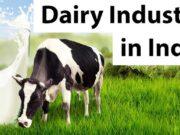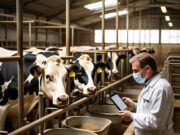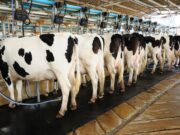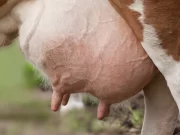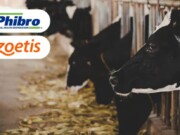
Climate is one of the major factors which affects milk production in cattle and buffaloes. India has three major seasons; winter, summer, and monsoon (rainy season) almost of equal duration. The winter season starts in the month of November. The dairy animals have to acclimatize themselves to the ambient temperature to keep them healthy and comfortable. Being a tropical country, Indian winter is very comfortable to dairy animals when they produce a good quantity of milk. However, severe winter particularly in Northern Region adversely affects milk production. To mitigate the impact of extremely cold weather, some amendments have to be made in the management of dairy cattle and buffaloes.
General Management:
It is essential to protect the animals from sudden falls in ambient temperature. This can be ensured by providing night shelter in covered sheds/spaces to animals. Curtains made of used jute bags or Poly Propylene (PP) bags can be used at night to cover the open areas of the shed. To protect animals from cold floors, soft and comfortable bedding material (dry grass, paddy straw, sawdust, etc.) should be provided in the shed and it should be kept dry and changed/aired frequently, preferably every day.
Used gunny bags or old blankets can be used to cover the body of individual animals, this arrangement will retain body heat and the animal will remain warm. Keeping animals in groups will make them warm due to close body contact. Animals should not be kept in damp areas and they should be protected from smoke (from fires lit to provide warmth). The dampness and smoke increase their chances of contracting pneumonia.


Feeding Management:
In order to cope with cold weather conditions, animals increase the production of body heat by increasing their heart rate and respiration. This increases blood flow and protects the animal from cold. They require more feed to maintain their body condition and milk production. Cattle and buffaloes may require up to 20 percent more feed during cold weather.
In order to cope with colder temperatures, cattle grow thick winter coats and increase the production of their body heat. They accomplish this by increasing their heart rate and respiration, thus increasing blood flow to keep their extremities from freezing. Although this physiological response enables cows to withstand extremely low temperatures in relative comfort, they also require more feed in order to maintain their body weight and milk production. So dairy animals need good quality nutritious feed and fodder supplemented with sufficient amounts of essential minerals and vitamins. Wholesome drinking water should also be made available to keep the animals hydrated.
Breeding Management:
Winter is the best season to plan breeding of cattle and buffaloes when fodder quality is at its best. Good quality nutritious feed and fodder increase the reproduction efficiency of dairy animals. This is the time when dairy farmers should keep an eye to detect heat (estrus) symptoms in their cows/buffaloes, and call AI technicians for timely insemination of the animals found in heat. Due care should be given to pregnant animals.
Health Management:
To keep dairy animals in good health during winter, they should be vaccinated against Foot & Mouth Disease (FMD), Haemorrhagic Septicaemia (HS), Black Quarter (BQ), and other vaccination for the diseases prevalent in the area. Winter is the right time to deworm the animals. Farmers need to take adequate care of milking animals to prevent the occurrence of Mastitis.
Winter calf management:
Calves born in winter are more prone to cold stress. Lower ambient temperature poses a threat to calf survival. So newborn calves less than 3 weeks of age should be effectively protected by putting a used gunny bag/ old blanket on their body, providing thick and dry bedding material, feeding cod liver oil and an additional quantity of milk/milk replacer to compensate the need of extra energy to keep them warm and healthy. Older calves should be fed with high protein calf starter, good quality hay, and mineral mixture. Young dairy calves have very little stored fat they can use for warmth so they need additional energy to keep them warm during cold weather.
Adequate preventive measures are necessary to combat cold stress (hypothermia) in newborn calves. Regular monitoring of the body temperature of the calf is necessary to rule out hypothermia. They should be kept clean and dry, hydrated, and healthy.

Tips for managing cattle and buffalo in the winter season:
The following tips would be quite useful for dairy farmers for keeping their cattle and buffaloes in good health and peak production during cold stress;
- Waterless cleaning of floors of animal buildings should be followed. If necessary, very little water should be used.
- During the daytime when the sun shines, animals should be kept out of the shed, preferably in the paddock if available. This will enable the farmer to clean the shed and keep it dry.
- High humidity decreases the insulating capability of cow coats, so it is important to reduce the humidity by keeping the shed and surrounding dry.
- If possible, animals should be given lukewarm water to drink.
- To maintain the body temperature/condition and milk production, dairy animals should be fed with a high-energy ration containing crushed maize, whole cotton seed, oil cakes, and jaggery.
- In winter, feeding time should be shifted towards the evening when the temperature falls. The activity involved in eating and the fermentation in the rumen will increase heat production to keep the animals comfortable.
- All dietary changes, be they increases or decreases, should be made gradually.
- Preventive vaccinations, deworming and mitigation of cold stress are necessary to keep dairy animals in good health in the winter season.
- Dairy farmers should ensure that breedable females are regularly watched for heat detection and that timely insemination of animals is done by trained AI Technicians.
Conclusion:
To keep the cattle and buffaloes in excellent health and peak production and reproduction, it is essential that they are kept warm, fed with high protein and energy-rich feed, and roughages fortified and supplemented with vitamins and minerals. They need to be comfortable, and energetic and keep normal and stable body temperatures in cold stress-free environments.
Dairy animals should be supported for maintaining their production as well as reproduction performance during the winter season. For this, preventive measures for disease control and proper reproduction management are crucial.

Authors:
Dr. Nirav Patel1
Dr. SR Patil2, and
Dr. MU Siddiqui3
